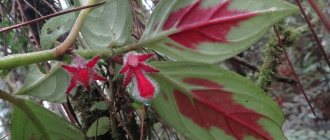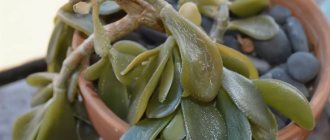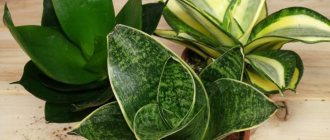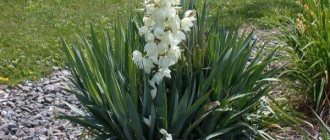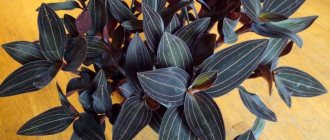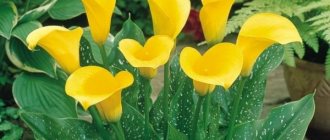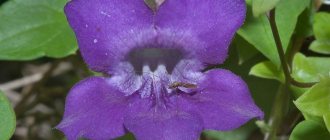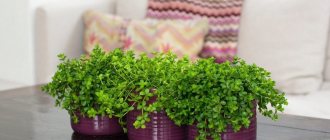Photo of Maranta - indoor perennials with variegated leaves of the Marantaceae family, a spectacular decoration for any room. Among the variety of crops, there are those most beloved by gardeners. One such plant is arrowroot (“praying grass”). It is valued for its attractive appearance and unpretentiousness.
The homeland of arrowroot is the tropical rainforests of South America. The flower was named in honor of the outstanding Italian scientist Bartolomeo Maranta, who became famous for his treatises on botanical pharmacology and antidotes.
The plant is a bush of erect shoots on which there are broad oval leaves covered, depending on the variety, with spots or patterns of various shades. At night, the plates take a vertical position. The culture reaches 30-35 cm in height. At home, flowering does not always occur. The buds are small, the petals are white or light purple.
Each specimen produces 5-6 new leaves during the growing season. The plant can live for decades if it is given proper care and propagated every 3-4 years.
Arrowroot is visually very similar to calathea and stromanta.
| The growth rate is low, 5-6 new leaves per year. |
| At home, flowering does not always occur. |
| The plant is easy to grow. |
| It is a perennial plant. |
Photo gallery
What kind of soil is needed?
Light, nutritious, breathable soil is considered suitable for arrowroot. The choice of ready-made store-bought mixtures is quite wide, but when purchasing, choose only those that were originally intended for arrowroot. This will be indicated on the packaging. Pay attention to the composition, which should contain leaf/turf soil, peat, humus and mineral complexes.
Among the disadvantages of the ready-made mixture, it can be noted that the substrate in its pure form still does not meet the requirements and requires additional additives - most often these are spruce needles, sphagnum and peat. Before planting, it is advisable to check the acidity of the substrate: the pH level should not exceed 6.0.
The soil needed for arrowroot is very easy to prepare yourself. The simplest option is a mixture of soil, peat and sand in proportions 3:2:1. Experienced gardeners advise, if possible, to add either sphagnum moss or crushed charcoal. The soil mixture should be quite loose. Pebbles, expanded clay, shards or coarse sand are suitable for drainage.
Transfer
The plant is replanted once every few years. Air permeability of the soil is an important condition for good growth. The pot is chosen to be wide, but not deep, because Maranta’s rhizome is small. An abundant drainage layer is a prerequisite for transplantation and subsequent comfortable substrate humidity.
If you recently purchased Maranta, it is not recommended to replant it immediately. The flower needs to be allowed to adapt to new conditions. This will take no more than three weeks. Then you can safely start transplanting. To do this, the plant is transferred with the original lump of earth into a new pot, into which soil is added. For active growth and the formation of new shoots, it is recommended to trim the leaves to the very base.
Reproduction
Can be propagated by cuttings or division. It is best to propagate by cuttings from May to the end of August. To do this, the best way is to cut the tops of new shoots with 2-3 healthy internodes.
Place them in water, and after 4-5 weeks, when the roots reach 3 cm in length, the plants can be planted in a shallow pot. After planting for rooting, provide the arrowroot with a greenhouse effect by covering the pot with film.
Propagation by division is best done in the spring when transplanting the plant into another pot or changing the soil. Sterilize the knife and cut the bush so that each part remains completely viable. To do this, leave part of the roots and a growing point for each division.
Before placing the separated parts in the pot, do not forget to sprinkle crushed coal on the cut roots of each.
In this case, the plant will also need a greenhouse effect, so water the seedlings and cover them with a plastic bag or film.
Temperature
For healthy growth, arrowroot will need a stable temperature. Standard room conditions will serve as well as possible. It is advisable that both winter and summer the thermometer column be in approximately the same position - 20-25 degrees. Sudden changes in temperature will have a bad effect on the plant. Drafts will completely ruin it.
Photo 1. Tricolor arrowroot leaves
Fertilizer and feeding
Arrowroot needs mineral and organic fertilizers; it reacts sharply to the slightest excess feeding. Experienced flower growers recommend diluting all fertilizers with 2 times the amount of water specified in the instructions.
Fertilizing is relevant during the period of active growth - from the beginning of spring to the beginning of autumn. Organic and mineral fertilizers must be alternated and the soil must be fertilized once every 2 weeks. Pokon, Bona Forte and Agricola formulations have received many positive reviews.
Ordinary ash has the properties of organic fertilizer. It can be used to flavor the soil either in dry form or in a solution of 1 tablespoon of ash with 1 liter of clean, settled water.
But the mixture must first be kept for 24 hours and only then the substrate must be watered.
Species diversity
It is quite difficult to say exactly where exactly the flower migrated to our latitudes. But it was definitely either the central parts of the American continent or western India. It was in these corners of the globe that variegated grass was first discovered.
Most often in domestic homes, white-veined arrowroot is found - in a variety of variations. Occasionally, on the window sills and in the winter gardens of professional flower growers, you can see comb arrowroot. But this is rather an exception to the rule. This variety is quite rare and is rarely found in our area. Other popular varieties of arrowroot are presented in the table.
Table - Domesticated varieties of arrowroot and their characteristics
| Variety name | Background color | Peculiarities |
| Kerkhoven | — Medium intensity green | — The most popular variety; — brown spots are located on both sides of the middle vein; - weakly defined longitudinal veins |
| Massanzha | — Medium intensity green at the edge and light green in the center | — The second name is black arrowroot; — clearly defined longitudinal veins; - the presence of brown strokes between the transverse veins |
| Maricella | — Deep dark green | — The presence of a wide jagged stripe in the center of the sheet; - longitudinal veins of light color |
| Red vein or tricolor | — Dark green; - sometimes has a brown tint | — The presence of a light green stripe in the center; - pronounced longitudinal veins; - presence of clear burgundy veins on the sides |
| Beauty Kim | — Medium intensity green | — The presence of dark green and sometimes brown spots on the leaf; — the presence of specks of yellow-light green color; - large fragments of light colors |
| Emeral Beauty | — Medium intensity green | — Wide central stripe of light color; - presence of randomly placed light spots |
Watering
For irrigation you will need clean soft water up to 5 °C above room temperature. In summer, the flower needs increased moisture, and it should be watered at least once every 48 hours. In this case, it is necessary to control the general level of humidity of the substrate so that the roots do not rot.
For additional moisture, initially place the arrowroot on a tray filled with gravel or expanded clay filled with water.
In winter, water the flower no more than 1-2 times a week, depending on the degree of dry air caused by the heating season.
How to organize watering during a long absence?
The lack of necessary moisture leads to rapid drying out of the arrowroot. If you are going on vacation, make sure in advance that the flower has access to a source of moisture. To do this, you can use 3 options:
- Place wet sphagnum moss on the surface of the substrate. This will help retain moisture in the roots.
- Place a layer of expanded clay, pebbles or sand in a drainage pan and fill everything with water. Place the arrowroot on top so that the bottom of the pot does not directly touch the water.
- If possible, place the plant in a florarium.
Description of the plant
Arrowroot is a herbaceous perennial. The homeland of this plant is the swampy tropics of America. The name is associated with the name of the scientist B. Maranta.
In the wild, arrowroot is a small plant, about 20 cm in height, with straight or creeping shoots. The leaves, depending on the type, are lanceolate, round or oblong. Against a smooth background (its color can be different - from very light to dark green), spots and veins stand out clearly.
Spots and veins stand out brightly against the even background of arrowroot leaves.
Arrowroot is often confused with its relative Calathea. However, these plants have obvious differences. Calathea is taller (from 60 cm to 1 m), with long delicate leaves. They, unlike arrowroot leaves, are arranged on the petioles in two rows. In addition, arrowroot flowers are inconspicuous, while calathea flowers are spectacular and bright.
The leaves of arrowroot are so unusual and beautiful that this plant is bred precisely because of their decorative properties. The plant is unpretentious in care and adapts well to home or office conditions, in open and closed florariums.
The peculiarity of arrowroot is that when the plant feels good, it places the leaves horizontally, but under unfavorable conditions (especially in low light), the leaves fold and rise vertically. For this reason, the plant was nicknamed “praying grass.”
Diseases
There are no specific diseases unique to the arrowroot family. All problems are caused by simple carelessness of the owner or failure to comply with mandatory care conditions.
Any ailment of the arrowroot will be clearly demonstrated by its appearance. There is a high probability that growth will stop. All this is provoked by three main reasons: root rotting, insect damage and insufficient air humidity.
The fact that rotting has occurred in the root system can be recognized by wilted leaves in wet soil. Most likely, the flower suffers from low temperatures due to abundant watering or poor-quality soil. To eliminate the problem, it is necessary to dry the soil, eliminate the affected areas and establish a proper watering regime. In some cases, it makes sense to transplant the arrowroot into a new sterilized substrate.
Types of arrowroot
- Tricolor (tricolor). This is a plant with dark green leaves edged with a paler color. There are light green streaks running down the center. The dark red veins become darker towards the edges. Tricolor arrowroot is the most unpretentious and widespread type of this plant.
- White veined (Fascinator). The leaves are oval, reaching a length of 15 cm. Features: on the dark green leaves there is a silver stripe running down the center. Along with the tricolor, it is unpretentious.
- Arrowroot two-color. Quite a rare species with dark green leaves, on which light specks are scattered.
- Reed arrowroot. This plant can reach a height of 1 m. The leaves are oval, elongated, and have a gray tint.
Varieties in the photo
White vein has another name - Fascinator
Tricolor arrowroot is the most common type for home growing.
Reed arrowroot can grow up to 1 m
Two-color arrowroot is rare
Pests
There are two dangerous pests for arrowroot - scale insects and spider mites.
Shchitovka
A very small insect, up to 5 mm in size, with a waxy shield that completely covers its body. Appears on the flower if care is not accompanied by regular air humidification; it feeds on arrowroot juice.
Affected leaves can be easily identified by raised bumps or plaques of green, brown or yellow color on the outside or inside. If the arrowroot is infected quite recently, and the scale insect is not yet visible to the naked eye, it can be detected by the sticky secretion on the flower that it leaves.
Insect control is carried out using a soap solution and insecticides. Using a cotton swab dipped in soapy water, thoroughly wipe the leaves to remove adult insects.
The same can be done using Karbofos solution. After this, spray the flower with one of the following products: Aktara, Bankol, Mospilan, Actellik or their analogues. At the same time, do not forget to treat the surface on which the flower stands.
If the arrowroot is on the windowsill, even the nearest window glass must be treated.
Spider mite
Microscopic arthropod insect. Infected leaves are distinguished by small yellow dots, which subsequently merge into one large spot. The mite appears due to dry air; in some cases, the cause is called, on the contrary, excessive humidity. At the same time, the tick can be brought into the apartment already on the leaves of an infected arrowroot, in a purchased substrate, or in the soil from the street.
Get rid of the pest by wiping the leaves and stem with soapy water and acaricides. Among the most effective are Vertimek, Akarin, Neoron, Fitoverm and Actellik.
To prevent scale insects and spider mites, do not forget to systematically moisten the room where the flower is located. Do not place any purchased cut bouquets next to arrowroot. And keep all new purchased plants in a 3-week quarantine in another room.
Possible problems
If you do not care for the arrowroot correctly or do not provide it with suitable conditions, then problems may begin with it:
- The tips of the leaves dry out. If the air in the room is too dry, then the tops of the leaves turn brown and dry out, they even sometimes fall off. Also, due to low humidity, the growth of the bush may become slower.
- Rot has appeared . If in winter the plant is watered excessively or it is kept in the cold, then its shoots may lose turgor, and rot may also form on them.
- Spots on foliage . If a flower feels a lack of moisture, then spots form on its leaf plates, they begin to curl, and yellowing of the lower foliage is also observed.
- The bush becomes faded . The plant reacts extremely negatively to direct sunlight, which causes the leaves to lose their spectacular color and dry out.
- Harmful insects . The greatest danger to him is represented by spider mites.
Errors when leaving
Any deviation from the rules for maintaining arrowroot is immediately reflected in the condition of its leaves. They curl, dry out or turn yellow. The flower suffers from certain mistakes of novice gardeners, and the most common of them are:
- unacceptably dry air;
- insufficient soil moisture;
- too heavy, unsuitable soil;
- the flower is exposed to the negative influence of direct sunlight;
- the flower is in a draft;
- the air temperature has dropped below the permissible 17 °C;
- arrowroot is affected by insects in a neglected form.
Maranta will enliven and decorate any interior. If you don’t already have such a flower, you can purchase or order it from flower shops. The cost depends on the type of plant, region and place of sale, and ranges from 150 to 900 rubles.
What to do if arrowroot leaves turn yellow and dry? Main diseases and pests
No matter how hard the gardener tries to keep his pets in comfortable conditions, sometimes it is not possible to avoid certain diseases that will spoil the appearance of the flower and can even lead to its death.
Basically, many diseases that affect indoor plants arise due to improper care, watering regime and unfavorable environment.
